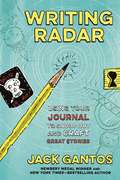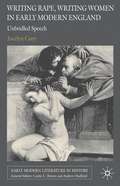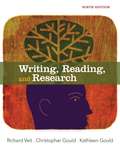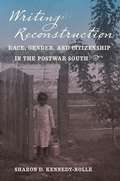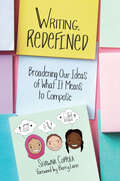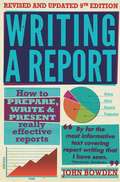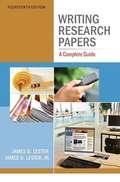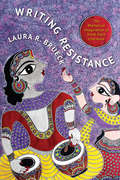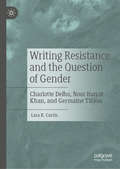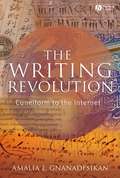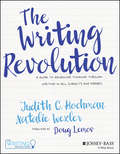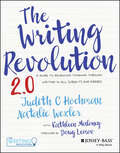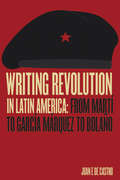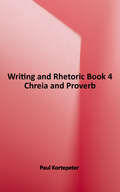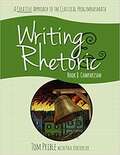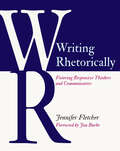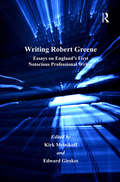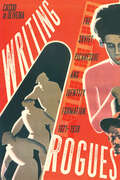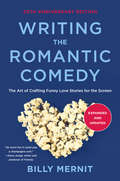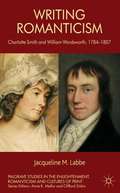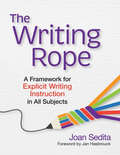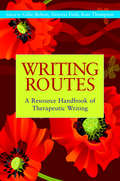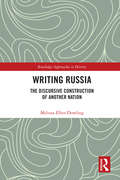- Table View
- List View
Writing Radar: Using Your Journal to Snoop Out and Craft Great Stories
by Jack GantosThe Newbery Award–winning author of Dead End in Norvelt shares advice for how to be the best brilliant writer in this funny and practical creative writing guide perfect for all kids who dream of seeing their name on the spine of a book.With the signature wit and humor that have garnered him legions of fans, Jack Gantos instructs young writers on using their "writing radar" to unearth story ideas from their everyday lives. Incorporating his own misadventures as a developing writer, Gantos inspires readers to build confidence and establish good writing habits as they create, revise, and perfect their stories. Pop-out text boxes highlight key tips, alongside Gantos's own illustrations, sample stories, and snippets from his childhood journals. More than just a how-to guide, Writing Radar is a celebration of the power of storytelling and an ode to the characters who—many unwittingly—inspired Gantos's own writing career.
Writing Rape, Writing Women in Early Modern England
by Jocelyn CattyThe word 'rape' today denotes sexual appropriation; yet it originally signified the theft of a woman from her father or husband by abduction or elopement. In the early modern period, its meaning is in transition between these two senses, while rapes and attempted rapes proliferate in literature. This age also sees the emergence of the woman writer, despite a sexual ideology which equates women's writing with promiscuity. Classical myths, however, associate women's story-telling with resistance to rape. This comprehensive study of rape and representation considers a wide range of texts drawn from prose fiction, poetry and drama by male and female writers, both canonical and non-canonical. Combining close attention to detail with an overview of the period, it demonstrates how the representation of gender-relations has exploited the subject of rape, and uses its understanding of this phenomenon to illuminate the issues of sexual and discursive autonomy which figure largely in women's texts of the period.
Writing, Reading, and Research (9th Edition)
by Richard Veit Christopher Gould Kathleen GouldThis text is a composition course that prepares students for the tasks they will face during their college and professional careers developing skills in writing, reading and analyzing information.
Writing Reconstruction
by Sharon D. Kennedy-NolleAfter the Civil War, the South was divided into five military districts occupied by Union forces. Out of these regions, a remarkable group of writers emerged. Experiencing the long-lasting ramifications of Reconstruction firsthand, many of these writers sought to translate the era's promise into practice. In fiction, newspaper journalism, and other forms of literature, authors including George Washington Cable, Albion Tourgee, Constance Fenimore Woolson, and Octave Thanet imagined a new South in which freedpeople could prosper as citizens with agency. Radically re-envisioning the role of women in the home, workforce, and marketplace, these writers also made gender a vital concern of their work. Still, working from the South, the authors were often subject to the whims of a northern literary market. Their visions of citizenship depended on their readership's deference to conventional claims of duty, labor, reputation, and property ownership. The circumstances surrounding the production and circulation of their writing blunted the full impact of the period's literary imagination and fostered a drift into the stereotypical depictions and other strictures that marked the rise of Jim Crow. Sharon D. Kennedy-Nolle blends literary history with archival research to assess the significance of Reconstruction literature as a genre. Founded on witness and dream, the pathbreaking work of its writers made an enduring, if at times contradictory, contribution to American literature and history.
Writing, Redefined: Broadening Our Ideas of What It Means to Compose
by Shawna CoppolaWhat does it mean to write or to be a writer? In Shawna Coppola's book Writing, Redefined: Broadening Our Ideas of What It Means to Compose, she challenges the reader to expand beyond standard alphabetic writing and consider alternative forms of composition when assigning writing to students. This book empowers teachers to change what counts as writing in schools and classrooms, opening the door to students who may not consider themselves to be writers, but should and can. Inside you'll find alternative, engaging writing assignments that are visual, aural, or multimodal that will involve all students, specifically those: Who prefer to compose using a wider array of forms and modes For whom standard English is not the norm Who have been identified as dyslexic Whose cultural traditions lean heavily towards more aural forms of composition Who are considered struggling writers By finding ways to accommodate all styles of writers, students are free to unleash their creativity and share their story with others. While there is no question composition in written form is important and worth of study, broadening our definition of writing expands an enormous range of possibilities for composing for all students.
Writing A Report, 9th Edition: How to prepare, write & present really effective reports
by John BowdenNow in its 9th edition, this extensively revised and updated handbook explains how you can write reports that will be: * Read without unnecessary delay * Understood without undue effort Accepted, and where applicable, acted upon / Divided into three parts, the book looks in detail firstly at the practical side of report writing: * Preparation and planning * Collecting and handling information * Writing and revising / Secondly, at the creative side of report writing: * Achieving a good style and choosing the correct words * Improving the overall appearance of reports / And thirdly at 23 common types of report, including: * Annual reports/ Appraisal reports * Audit reports Minutes/Progress reports * Student project reports/Technical reports / There is also an extensive glossary and a selection of sample reports.
Writing A Report, 9th Edition: How To Prepare, Write And Present Really Effective Reports
by John BowdenNow in its 9th edition, this extensively revised and updated handbook explains how you can write reports that will be: * Read without unnecessary delay * Understood without undue effort Accepted, and where applicable, acted upon / Divided into three parts, the book looks in detail firstly at the practical side of report writing: * Preparation and planning * Collecting and handling information * Writing and revising / Secondly, at the creative side of report writing: * Achieving a good style and choosing the correct words * Improving the overall appearance of reports / And thirdly at 23 common types of report, including: * Annual reports/ Appraisal reports * Audit reports Minutes/Progress reports * Student project reports/Technical reports / There is also an extensive glossary and a selection of sample reports.
Writing Research Papers: A Complete Guide (Fourteenth Edition)
by James D. LesterThis market-leading text provides readers with step-by-step guidance through the research writing process, from selecting and narrowing a topic to formatting the finished document. Writing Research Papers backs up its instruction with the most complete array of samples of any writing guide of this nature. The text continues its extremely thorough and accurate coverage of citation styles for a wide variety of disciplines. The fourteenth edition maintains Lester's successful approach while bringing new writing and documentation updates to assist the student researcher in keeping pace with electronic sources.
Writing Resistance: The Rhetorical Imagination of Hindi Dalit Literature (South Asia Across the Disciplines)
by Laura BrueckWriting Resistance is the first close study of the growing body of contemporary Hindi-language Dalit (low caste) literature in India. The Dalit literary movement has had an immense sociopolitical and literary impact on various Indian linguistic regions, yet few scholars have attempted to situate the form within contemporary critical frameworks. Laura R. Brueck's approach goes beyond recognizing and celebrating the subaltern speaking, emphasizing the sociopolitical perspectives and literary strategies of a range of contemporary Dalit writers working in Hindi.Brueck explores several essential questions: what makes Dalit literature Dalit? What makes it good? Why is this genre important, and where does it oppose or intersect with other bodies of Indian literature? She follows the debate among Dalit writers as they establish a specifically Dalit literary critical approach, underscoring the significance of the Dalit literary sphere as a "counterpublic" generating contemporary Dalit social and political identities. Brueck then performs close readings of contemporary Hindi Dalit literary prose narratives, focusing on the aesthetic and stylistic strategies deployed by writers whose class, gender, and geographic backgrounds shape their distinct voices. By reading Dalit literature as literature, this study unravels the complexities of its sociopolitical and identity-based origins.
Writing Resistance and the Question of Gender: Charlotte Delbo, Noor Inayat Khan, and Germaine Tillion
by Lara R. CurtisThis book presents the first comparative study of the works of Charlotte Delbo, Noor Inayat Khan, and Germaine Tillion in relation to their vigorous struggles against Nazi aggression during World War II and the Holocaust. It illuminates ways in which their early lives conditioned both their political engagements during wartime and their extraordinary literary creations empowered by what Lara R. Curtis refers to as modes of ‘writing resistance.’ With skillful recourse to a remarkable variety of genres, they offer compelling autobiographical reflections, vivid chronicles of wartime atrocities, eyewitness accounts of victims, and acute perspectives on the political implications of major events. Their sensitive reflections of gendered subjectivity authenticate the myriad voices and visions they capture. In sum, this book highlights the lives and works of three courageous women who were ceaselessly committed to a noble cause during the Holocaust and World War II.
The Writing Revolution: Cuneiform to the Internet (The Language Library #25)
by Amalia E. GnanadesikanIn a world of rapid technological advancements, it can be easy to forget that writing is the original Information Technology, created to transcend the limitations of human memory and to defy time and space. The Writing Revolution picks apart the development of this communication tool to show how it has conquered the world. Explores how writing has liberated the world, making possible everything from complex bureaucracy, literature, and science, to instruction manuals and love letters Draws on an engaging range of examples, from the first cuneiform clay tablet, Egyptian hieroglyphs, and Japanese syllabaries, to the printing press and the text messaging Weaves together ideas from a number of fields, including history, cultural studies and archaeology, as well as linguistics and literature, to create an interdisciplinary volume Traces the origins of each of the world’s major written traditions, along with their applications, adaptations, and cultural influences
The Writing Revolution
by Amalia E. GnanadesikanIn a world of rapid technological advancements, it can be easy to forget that writing is the original Information Technology, created to transcend the limitations of human memory and to defy time and space. The Writing Revolution picks apart the development of this communication tool to show how it has conquered the world.Explores how writing has liberated the world, making possible everything from complex bureaucracy, literature, and science, to instruction manuals and love lettersDraws on an engaging range of examples, from the first cuneiform clay tablet, Egyptian hieroglyphs, and Japanese syllabaries, to the printing press and the text messagingWeaves together ideas from a number of fields, including history, cultural studies and archaeology, as well as linguistics and literature, to create an interdisciplinary volumeTraces the origins of each of the world's major written traditions, along with their applications, adaptations, and cultural influences
The Writing Revolution: A Guide to Advancing Thinking Through Writing in All Subjects and Grades
by Natalie Wexler Judith C. Hochman"HELP! My Students Can't Write!" Why You Need a Writing Revolution in Your Classroom and How to Lead It. The Writing Revolution (TWR) provides a clear method of instruction that you can use no matter what subject or grade level you teach. The model, also known as The Hochman Method, has demonstrated, over and over, that it can turn weak writers into strong communicators by focusing on specific techniques that match their needs and by providing them with targeted feedback. Insurmountable as the challenges faced by many students may seem, TWR can make a dramatic difference. And the method does more than improve writing skills. It also helps: Boost reading comprehension Improve organizational and study skills Enhance speaking abilities Develop analytical capabilities TWR is as much a method of teaching content as it is a method of teaching writing. There's no separate writing block and no separate writing curriculum. Instead, teachers of all subjects adapt the TWR strategies and activities to their current curriculum and weave them into their content instruction. But perhaps what's most revolutionary about the TWR method is that it takes the mystery out of learning to write well. It breaks the writing process down into manageable chunks and then has students practice the chunks they need, repeatedly, while also learning content.
The Writing Revolution 2.0: A Guide to Advancing Thinking Through Writing in All Subjects and Grades
by Natalie Wexler Judith C. HochmanLead a writing revolution in your classroom with the proven Hochman Method Building on the success of the original best-seller, this new edition of The Writing Revolution adds valuable guidance for teachers seeking a way to bring their students' writing ability up to rigorous state standards. As thousands of educators have already discovered, The Writing Revolution provides the road map they need, clearly explaining how to incorporate the Hochman Method into their instruction, no matter what subject or grade they're teaching and regardless of the ability level of their students. The new edition provides a reorganized sequence of activities and even more student-facing examples, making it easier than ever to bring the method to your classroom. The Writing Revolution isn't a separate curriculum or program teachers need to juggle. Rather, it is a method providing strategies and activities that teachers can adapt to their preexisting curriculum and weave into their content instruction. By focusing on specific techniques that match their students' needs and providing them with targeted feedback, The Writing Revolution can turn weak writers into strong and confident communicators. In addition, the method can: Identify misconceptions and gaps in knowledge Boost reading comprehension and learning Improve organizational skills Enrich oral language Develop analytical abilities The Writing Revolution takes the mystery out of teaching students to write well.
Writing Revolution in Latin America: From Martí to García Márquez to Bolaño
by Juan E. De CastroIn the politically volatile period from the 1960s through the end of the twentieth century, Latin American authors were in direct dialogue with the violent realities of their time and place. Writing Revolution in Latin America is a chronological study of the way revolution and revolutionary thinking is depicted in the fiction composed from the eye of the storm.From Mexico to Chile, the gradual ideological evolution from a revolutionary to a neoliberal mainstream was a consequence of, on the one hand, the political hardening of the Cuban Revolution beginning in the late 1960s, and, on the other, the repression, dictatorships, and economic crises of the 1970s and beyond. Not only was socialist revolution far from the utopia many believed, but the notion that guerrilla uprisings would lead to an easy socialism proved to be unfounded. Similarly, the repressive Pinochet dictatorship in Chile led to unfathomable tragedy and social mutation.This double-edged phenomenon of revolutionary disillusionment became highly personal for Latin American authors inside and outside Castro's and Pinochet's dominion. Revolution was more than a foreign affair, it was the stuff of everyday life and, therefore, of fiction.Juan De Castro's expansive study begins ahead of the century with José Martí in Cuba and continues through the likes of Mario Vargas Llosa in Peru, Gabriel García Márquez in Colombia, and Roberto Bolaño in Mexico (by way of Chile). The various, often contradictory ways the authors convey this precarious historical moment speaks in equal measure to the social circumstances into which these authors were thrust and to the fundamental differences in the ways they themselves witnessed history.
Writing & Rhetoric Book 4: Chreia & Proverb
by Paul KortepeterThe Writing and Rhetoric series method employs fluent reading, careful listening, models for imitation, and progressive steps. It assumes that students learn best by reading excellent, whole-story examples of literature and by growing their skills through imitation. Each exercise is intended to impart a skill (or tool) that can be employed in all kinds of writing and speaking. The exercises are arranged from simple to more complex. What's more, the exercises are cumulative, meaning that later exercises incorporate the skills acquired in preceding exercises. This series is a step-by-step apprenticeship in the art of writing and rhetoric.
Writing & Rhetoric Book 8: Comparison
by Paul Kortepeter Tom PribleIn Writing & Rhetoric Book 8: Comparison (Student Edition), students will be writing well-crafted, six-paragraph expository essays comparing two subjects. Comparisons can be made between people, historical events, ideas, inventions, animals, foods"just about anything, really. The purpose of these essays is to analyze two subjects and use this comparison to demonstrate similarities and differences between them. In these essays, students will be making use of a range of writing skills, including the ability to inform, to describe, to narrate, and to analyze.
Writing Rhetorically: Fostering Responsive Thinkers and Communicators
by Jennifer FletcherWriting Rhetorically: Fostering Responsive Thinkers and Communicators, author Jennifer Fletcher aims to cultivate independent learners through rhetorical thinking. She provides teachers with strategies and frameworks for writing instruction that can be applied across multiple subjects and lesson plans. Students learn to discover their own questions, design their own inquiry process, develop their own positions and purposes, make their own choices about content and form, and contribute to conversations that matter to them. Inside this book, Fletcher helps remove some of the scaffolding and explains how to put in practice some methods which can successfully foster: Inquiry, Invention, and Rhetorical Thinking Writing for Transfer Paraphrasing, Summary, Synthesis, and Citation Skills Research Skills and Processes Evidence-Based Reasoning Rhetorical Decision Making' Rhetorical decision making helps students develop the skills, knowledge, and mindsets needed for transfer of learning: the ability to adapt and apply learning in new settings. The more choices students make as writers, the better prepared they are to analyze and respond to diverse rhetorical situations.' Writing Rhetorically' shows teachers what it looks like to dig into real texts with students and novice writers and how it develops them for lifelong learning.
Writing Robert Greene: Essays on England's First Notorious Professional Writer
by Kirk Melnikoff Edward GieskesRobert Greene, contemporary of Shakespeare and Marlowe and member of the group of six known as the "University Wits," is the subject of this essay collection, the first to be dedicated solely to his work. Although in his short lifetime Greene published some three dozen prose works, composed at least five plays, and was one of the period's most recognized-even notorious-literary figures, his place within the canon of Renaissance writers has been marginal at best. Writing Robert Greene offers a reappraisal of Greene's career and of his contribution to Elizabethan culture. Rather than drawing lines between Greene's work for the pamphlet market and for the professional theatres, the essays in the volume imagine his writing on a continuum. Some essays trace the ways in which Greene's poetry and prose navigate differing cultural economies. Others consider how the full spectrum of his writing contributes to an emergent professional discourse about popular print and theatrical culture. The volume includes an annotated bibliography of recent scholarship on Greene and three valuable appendices (presenting apocrypha; edition information; and editions organized by year of publication).
Writing Rogues: The Soviet Picaresque and Identity Formation, 1921–1938
by Cassio de OliveiraPlot elements such as adventure, travel to far-flung regions, the criminal underworld, and embezzlement schemes are not usually associated with Soviet literature, yet an entire body of work produced between the October Revolution and the Stalinist Great Terror was constructed around them.In Writing RoguesCassio de Oliveira sheds light on the picaresque and its marginal characters – rogues and storytellers – who populated the Soviet Union on paper and in real life. The picaresque afforded authors the means to articulate and reflect on the Soviet collective identity, a class-based utopia that rejected imperial power and attempted to deemphasize national allegiances. Combining new readings of canonical works with in-depth analysis of neglected texts, Writing Rogues explores the proliferation of characters left on the sidelines of the communist transition, including gangsters, con men, and petty thieves, many of them portrayed as ethnic minorities. The book engages with scholarship on Soviet subjectivity as well as classical picaresque literature in order to explain how the subversive rogue – such as Ilf and Petrov’s wildly popular cynic and schemer Ostap Bender – in the process of becoming a fully fledged Soviet citizen, came to expose and embody the contradictions of Soviet life itself.Writing Rogues enriches our understanding of how literature was called upon to participate in the construction of Soviet identity. It demonstrates that the Soviet picaresque resonated with individual citizens’ fears and aspirations as it recorded the country’s transformation into the first communist state.
Writing The Romantic Comedy, 20th Anniversary Expanded and Updated Edition: The Art of Crafting Funny Love Stories for the Screen
by Billy Mernit“Writing the Romantic Comedy is so much fun to read it could pop a champagne cork.”—Alexa Junge, writer and producer of FriendsRevised and expanded to celebrate a new generation of romantic comedies, Billy Mernit’s insightful look into the mechanics of writing Hollywood’s most enduring genre features case studies that reveal the screenwriting secrets behind classics new and old.Whether you’re a first-time screenwriter, an intermediate marooned in the rewriting process, or a professional wanting to explore the latest genre trends, this thoroughly charming and insightful guide to the basics of crafting a winning and innovative script will take you step by step from “meet cute” all the way to “joyous defeat.” You’ll learn the screenwriting secrets behind some of the funniest scenes ever written; how to create characters and dialogue that getsparks flying; why some bedroom scenes sizzle and others fall flat; and much more. Written in a refreshingly accessible style and updated and expanded to recognize the contributions of a fresh generation of romantic comedies, this newly revised 20th Anniversary edition of Writing the Romantic Comedy features case studies drawn from beloved romantic classics such as When Harry Met Sally, Annie Hall, Tootsie, and The Lady Eve to modern-day favorites including Hitch, (500) Days of Summer, Bridesmaids, and Silver Linings Playbook. Field-tested writing exercises are also included, guaranteed to short-circuit potential mistakes and ensure inspiration.
Writing Romanticism
by Jacqueline M. LabbeWhat is 'Wordsworthian' Romanticism and how did it evolve? This book argues that only by reading Charlotte Smith's poetry in tandem with William Wordsworth's can this question be answered, demonstrating their mutual contribution to the creation of the 'Wordsworthian', through literary analysis and historical contextualizing of their writings.
The Writing Rope: A Framework for Explicit Writing Instruction in All Subjects
by Joan Sedita Jan HasbrouckWriting is a task as complex and multifaceted as reading—but it’s often taught as a single skill. Discover how to plan and deliver comprehensive, explicit, and evidence-based writing instruction with this groundbreaking book, aligned with IDA’s Structured Literacy approach and based on the latest research. <p><p> Joan Sedita's innovative Writing Rope weaves multiple skills and strategies into five fundamentals of a comprehensive writing curriculum: critical thinking, syntax (sentences), text structure, writing craft, and transcription (spelling and handwriting). Teachers of Grades 4-8 will get crystal-clear guidelines that demystify the process of helping students learn to write and write to learn across academic content areas. And with dozens of included templates, handouts, and other resources—available for download online—teachers will have all the tools they need to design and deliver explicit, high-quality writing instruction. <p><p> Perfect for professional development, this invaluable planning guide will help teachers apply the science of reading to the skill of writing—and help students master a critically important aspect of literacy.
Writing Routes
by Kate Thompson Victoria Field Gillie BoltonThe use of creative writing as a route to personal or professional development is a powerful therapeutic tool, yet often the most difficult part is knowing how and where to begin. The experiences of others, and the strategies and approaches they have used in their own writing, can provide tried-and-tested models for practice, and 'ways in' that facilitators might wish to recommend to others. Writing Routes is an essential roadmap for anybody setting out on the journey of self-discovery through words. This diverse collection of short pieces introduce and demonstrate many different ways of getting into and thinking about creative writing for personal or professional development. Seventy contributors from a variety of different backgrounds and circumstances explain how they came to write a particular piece and why, how they found ways of transforming their experience into writing, and how it was beneficial to them. Their writing ranges widely, from journal entries and stream of consciousness to autobiography, poetry, fiction and drama, and the pieces are organised by theme and genre for ease of navigation, designed to be 'dipped into' as and when they are needed. This rich and varied collection will provide writing practitioners, counsellors and other related professionals with ideas and techniques to share with their clients, and is a useful resource that individuals who write for their own personal and professional development will return to again and again.
Writing Russia: The Discursive Construction of AnOther Nation (Routledge Approaches to History #46)
by Melissa-Ellen DowlingWriting Russia offers the first systematic analysis of Anglophone national histories of Russia. By deconstructing preeminent historical works on the history of Russia, this book provides insight into the hidden ideological underpinnings of the texts and their representations of Russia in the West. It demonstrates that historians employ a range of literary techniques to smooth over contradictions in their narratives of Russia, generating a seemingly cohesive depiction of Russia as a liminal, Other nation. This is a process that this book theorises as "discordus", representing an original conceptual framework for examining national history texts. It identifies patterns in the language and emplotment of Anglophone Russian histories across several defining historical epochs from the Mongol conquests to the Putin presidency, revealing the extent to which historians wield the narrative power to "make or break" nations. Postmodern in approach, the work pushes the boundaries of historiography and calls into question the nature of history.
